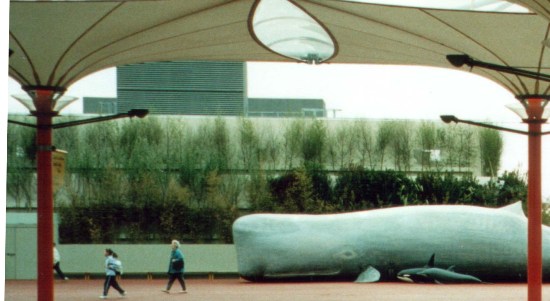Green walls
[edit] Introduction
The government’s 25 Year Environment Plan drives forward the agenda of a ‘cleaner and greener’ Britain. The plan lays out the government’s intention to enforce mandatory requirements on developers to integrate green infrastructure in the built environment. It seeks to integrate more stringent green considerations into building planning, and successfully captures the shift in sustainability goals by embedding an ‘environmental net gain’ principle.
The challenge faced in increasingly dense cities such as London however, is the scarcity of open areas for the development of green space. The solution is to be innovative with the space we do have. Integrating green infrastructure in dense, inner-city space is possible by seeking opportunities on buildings’ facades, transforming the dull, urban grey into green walls.

|
[edit] Green walls
More than just attractive architectural statements of environmental consciousness, green walls have a role to play in improving our cities as the rate and intensity of urbanisation accelerates.
Green walls provide large surface areas for pollutant deposition and can result in local reduction in concentrations of particulate matter between 10-20%. Within street canyons, this can increase to a reduction of particulate matter by 60% and nitrogen dioxide by 40%.
In addition to air quality, green walls are a key component of a city’s functional network of green spaces. Not only do they provide new habitats, but they also facilitate movement between habitats by contributing to networks of green corridors across vast urban space.
The benefits of green walls are not limited to the environmental but also span across the social reaches of sustainability. Green walls present an opportunity to use limited space to improve the quality of life for people in urban areas. The positive links made between the natural environment and an individual’s sense of wellbeing, stress reduction and mental regeneration are amongst the well-established restorative benefits of contact with nature. Studies also show that green facades can absorb sound energy that would normally be reflected by concrete, glass and steel and can reduce sound levels from traffic by 15dB. This minimises the excessive noise that threatens the wellbeing of urban residents.
Green walls provide a healthy and functional way for cities to become more attractive, resilient and increase the quality of living for residents, whilst competing with issues of diminishing space in inner-urban environments.
At the East Wick and Sweetwater project, the project team sought to improve residents’ quality of life and the local environmental conditions within the Queen Elizabeth Olympic Park by designing in green walls on the facades of the new developments.
The green roofs on the St James’ Market project form part of The Crown Estates “Wild West End” strategy to connect St James’s Park in the south to Regents Park in the north via a building-integrated green corridor.
[edit] Related articles on Designing Buildings Wiki
Featured articles and news
Ebenezer Howard: inventor of the garden city. Book review.
The Grenfell Tower fire, eight years on
A time to pause and reflect as Dubai tower block fire reported just before anniversary.
Airtightness Topic Guide BSRIA TG 27/2025
Explaining the basics of airtightness, what it is, why it's important, when it's required and how it's carried out.
Construction contract awards hit lowest point of 2025
Plummeting for second consecutive month, intensifying concerns for housing and infrastructure goals.
Understanding Mental Health in the Built Environment 2025
Examining the state of mental health in construction, shedding light on levels of stress, anxiety and depression.
The benefits of engaging with insulation manufacturers
When considering ground floor constructions.
Lighting Industry endorses Blueprint for Electrification
The Lighting Industry Association fully supports the ECA Blueprint as a timely, urgent call to action.
BSRIA Sentinel Clerk of Works Training Case Study
Strengthening expertise to enhance service delivery with integrated cutting-edge industry knowledge.
Impact report from the Supply Chain Sustainability School
Free sustainability skills, training and support delivered to thousands of UK companies to help cut carbon.
The Building Safety Forum at the Installershow 2025
With speakers confirmed for 24 June as part of Building Safety Week.
The UK’s largest air pollution campaign.
Future Homes Standard, now includes solar, but what else?
Will the new standard, due to in the Autumn, go far enough in terms of performance ?
BSRIA Briefing: Cleaner Air, Better tomorrow
A look back at issues relating to inside and outside air quality, discussed during the BSRIA briefing in 2023.
Restoring Abbotsford's hothouse
Bringing the writer Walter Scott's garden to life.
Reflections on the spending review with CIAT.
Retired firefighter cycles world to raise Grenfell funds
Leaving on 14 June 2025 Stephen will raise money for youth and schools through the Grenfell Foundation.
Key points for construction at a glance with industry reactions.























